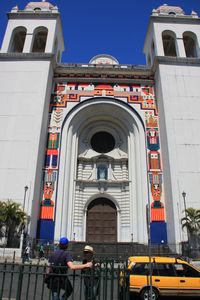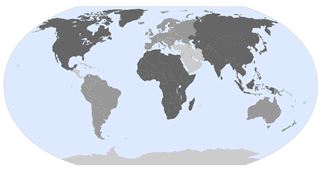Advertisement
Published: February 23rd 2011

 Bright Spot
Bright Spot
Cathedral in the centre of San SalvadorWe were less than impressed as we entered San Salvador after a long bus trip from the other side of Guatemala. The level of litter, always about in Central America, seemed to increase as we neared the capital and I guess it was fortunate that nightfall came before we had to come to grips with the look of the capital itself. The Tica Bus delivered us to its base. Typically for here, the bus was backed into a small compound with good, strong steel doors topped with razor wire. We had found a hotel that looked reasonable not too far away but the only taxi in evidence on a very dark street had an occupant. All of the advice is not to walk around this city after dark so we weren't going far without finding a ride so we walked towards the taxi. The driver was more than happy to load all four of us, and our packs, into his vehicle. The other occupant just looked on quietly as we, apparently, hijacked his ride.
They don't seem to do street lighting in San Salvador. It is no wonder that the boogey men come out. Our taxi driver was on their

 Another Travel Day
Another Travel Day
Leaving the hostel in San Salvadorside. Each time we drove down a dark street, in a spirit of comradeship, he turned off his headlights. He did switch them on for more major roads – sometimes – but you really only need lights if you don't know where to go. This bloke knew where he was going and to blazes with anyone who wanted to see us. Our hotel though was great. Clean, well appointed and very nice people running the Hotel Tazumal. Very good security too, just quietly. We did venture out to a local Italian restaurant – just 100 metres away.
In daylight San Salvador was not much better. The centre of town would be kindly described as a shithole. In the suburbs there seem to be places that are better and we didn't feel at all under threat as we walked the 3 or 4 kilometres to and from the centre. In fact, again, people were friendly and helpful. Unfortunately, they have a government that is not capable of putting in place basic services or maintaining public order. San Salvador averages 13 murders a day and rates as one of the most dangerous cities in the world.
Most people head for

 San Salvador Street
San Salvador Street
In one of the better residential areasthe beaches in El Salvador. We aren't so into beaches that we seek them out too much. El Salvador, for us, is more about the battle the people had to change their government to one that seemed more likely to provide something for the bulk of the people. Alegria sounded like a nice place to spend a couple of days and then we intended to go to Perquin, the place that was pretty much the heart of the revolution in the 1980s and 1990s.
Getting to Alegria was interesting. We took a taxi across San Salvador to the Oriente Autobus Estacion. After a discussion – mainly between Adam and various local advisors – we climbed onto a bus that would take us along the Intramerica Highway and let us off at a corner where we could get a bus for Santiago de Maria. Once we were nicely settled and were dealing with the stream of sellers that make their way through buses here there was a sudden uproar It seemed that we, and everyone else on a pretty full bus, had to get off that bus and get on another. Huge rush, a lot of yelling but we found

 Alegria Shop Entry
Alegria Shop Entry
There are lots of art and artesan shops in Alegriaseats on the new bus and off we went. Eventually, off-loaded at the roadside and quickly on to a little bus to go to Santiago. Not far on that one and then off-loaded again. Needed to ask then to find where the Alegria bus might be. Ancient school bus but it had an 'Alegria' sign on it. Sat for an hour waiting. Suddenly bus filled up very full and off we went. Packs with us this time and on our laps for most of the way.
Alegria an attractive and very clean place. People were very welcoming. The hostel Casa de Huespedes La Palma was reasonable and comfortable. We had the best local restaurant recommended strongly. It was OK but lost a bit of its lustre when we had to climb a massive hill to get home. Not daunted we climbed another hill – much, much larger – the next day to see a local crater lake. The walk down was a lot easier. That night we had dinner in a restaurant that had been canned in Lonely Planet but which we found to be excellent. Easily the best meal we had eaten in this part of the world.

 Parque de Alegria
Parque de Alegria
A very nice town square in a very nice townWe are becoming more and more disillusioned with poor old LP.
Perquin is not really all that far from Alegria. It did take most of the day to get there though on the local buses. It is a little place up in the mountains. Not so much razor wire in evidence here although the people are still careful. With their history this is to be expected. We found a lady who had rooms to let in a house. Turned out that we had the house to ourselves for most of the next few days and, while the house was basic, it was nice to be in a place on our own.
Many, many years ago friends tried to get me to go to a demonstration at the USA embassy in Canberra. There was fighting in El Salvador and the US was involved in providing arms and support to one side. Many people were being killed and the international outrage, in those days, was in its infancy. I didn't go to the demo. I can't remember the reason. It probably wouldn't have done any good anyway but I may have felt a little better when I was confronted with

 Contemplating the Climb
Contemplating the Climb
Pat & Klaire down (one of) the hill(s) in Alegriathe details of the massacre of babies, women and old people at El Mozote.
No-one knows precisely how many died at El Mozote in 1981. There are 800 names on the memorial. Our guide told us that the figure is 1,116. The official UN inquiry was not able to come up with a final figure but was able to say that well in excess of 500 bodies were buried in mass graves. The men were away working on farms – or, perhaps more likely, fighting. There were only old people, women and children there. There were only three survivors of a large group of people who were gathered. When the guerrillas made it back into Mozote years later, skeletons of women and children were still hanging from a large mango tree. A common grave held bones of hundreds of children. An eyewitness told of babies being thrown in the air and caught on bayonets. Many of the babies killed were less than a year old.
The El Salvodorean Army had a strategy of 'removing the water from the fish'. Kill the wives and children and the guerrillas would have no reason or capacity to fight. They fought for

 Alegria
Alegria
This one from the mountain on the way to the crater lakeanother 10 years – but then who wouldn't? The peace didn't give them victory but there were gains.
Our guide was a man who was a 12 year old in nearby Perquin when the Mozote massacre occurred. He was part of the guerrilla force 3 years later. He made it very clear that there was fault on both sides of this war. The FSLN had committed crimes just as the Government forces had. There was no winner in this war and certainly no one whose hands were clean. We were left stunned and saddened. You wonder what kind of people can do this sort of thing but you curse the governments of other countries who supported those who committed these atrocities.
We left El Salvador on local buses from Perquin to Marcala in Honduras. A great ride through a minor road in the mountains with a driver who had a difficulty with people who might be in front of him. Luckily for us, his confidence was matched by his driving ability. We crossed the border with just a short stop outside the Honduras Immigration and Customs Office – for the driver and a lady to wander off for

 Hill Climb
Hill Climb
On the way to the crater lakequite a while. The rest of the passengers, including us, sat quietly and waited. Then on to Marcala, which was very lively for a Sunday morning.
From Marcala we travelled to Tegucigalpa in Honduras. Another difficult and dirty city. We did find a shopping mall that was completely at odds with the rest of the place but there is no doubt that leaving Tegus was the best part of our experience. We won't miss the loud explosions – probably just big firecrackers – the roaring buses and cars, the noise from the bar across the road on a footy night and the pollution.
On now to Nicaragua where we intend to stay a while before a quick skate through the remainder of Central America to catch a plane from Panama to Colombia.
Advertisement
Tot: 0.058s; Tpl: 0.013s; cc: 12; qc: 29; dbt: 0.0303s; 1; m:domysql w:travelblog (10.17.0.13); sld: 1;
; mem: 1.1mb



























Flights from Zimbabwe to UK
non-member comment
flightsandbeyond@gmail.com
Wow, cool photos and what a blog. The diversity is amazing really.